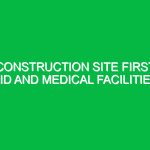Introduction
Scaffolding and work platforms are essential tools used in construction and maintenance. They provide the necessary height and support for workers to safely reach elevated areas. However, the safe use of scaffolding and work platforms is crucial in the Health, Safety, and Environment (HSE) domain. When used correctly, they help prevent accidents and injuries, ensuring that everyone goes home safely at the end of the day. This article will explore the hazards associated with scaffolding, the safety precautions that should be taken, and the regulations that govern their use.
Hazards of Scaffolding and Work Platforms
Understanding the hazards associated with scaffolding and work platforms is the first step to ensuring safety on construction sites. Here are some of the key hazards:
1. Falls from Height
One of the most significant risks when working on scaffolding is falling. Workers can slip and fall if they do not use proper safety gear or if the scaffolding is not adequately secured. For example, a worker standing on a high scaffold without a guardrail is at risk of falling off and suffering serious injuries.
2. Structural Instability
Scaffolding can become unstable if it is not built correctly or if it is overloaded with too much weight. This instability can lead to collapses, putting everyone nearby at risk. An example of this could be a scaffold designed for three workers that ends up supporting five, leading to its failure.
3. Falling Objects
Tools, materials, or debris can fall from scaffolding and hit people below. Properly securing tools and materials is essential to prevent this hazard. For instance, if a hammer is left unattended on the edge of a scaffold, it can easily fall and injure someone walking below.
4. Weather Conditions
Weather can also pose a hazard for those working on scaffolding. Windy, rainy, or icy conditions can make scaffolding slippery and hazardous. Workers must be aware of the weather and how it can affect their safety. For example, working on a scaffold during a heavy rainstorm can create slippery surfaces that increase the risk of falls.
Safety Precautions for Scaffolding and Work Platforms
To minimize risks and ensure safe working conditions, several safety precautions should be taken when using scaffolding and work platforms.
1. Use Proper Safety Gear
All workers should wear appropriate personal protective equipment (PPE). This includes hard hats, safety goggles, and non-slip footwear. Harnesses and lanyards should also be used when working at significant heights to prevent falls. For example, a worker on a scaffold should always wear a harness attached to a stable point to avoid falling.
2. Inspect Scaffolding Regularly
Before using scaffolding, it should be thoroughly inspected for any signs of damage or instability. A qualified person should perform these inspections regularly. For instance, checking for bent poles or loose connections can prevent accidents before they happen.
3. Ensure Proper Assembly
Scaffolding must be assembled according to the manufacturer’s instructions. This includes ensuring that all components are in good condition and securely connected. For example, if a scaffold system requires cross braces, they must be installed correctly to provide support. Failure to follow assembly instructions can lead to structural failure.
4. Maintain a Clean Work Area
Keeping the area around the scaffolding clean and free of debris can help prevent trips and falls. Tools and materials should be stored securely and out of the way. For instance, placing tools in designated spots rather than leaving them on the edge of the scaffold can significantly reduce risks.
5. Monitor Weather Conditions
Always check the weather before starting work on scaffolding. If conditions are unsafe, such as high winds or rain, work should be postponed. For example, if a storm is forecasted, it’s best to wait until the weather improves before using scaffolding.
Regulations and Standards
Various regulations and standards govern the safe use of scaffolding and work platforms. Compliance with these regulations is essential for maintaining a safe work environment.
1. OSHA Regulations (U.S.)
The Occupational Safety and Health Administration (OSHA) has specific regulations for scaffolding (29 CFR 1926.451). These regulations outline the requirements for scaffold design, construction, and use. For example, OSHA mandates that all scaffolds must be designed by a qualified person and that they must support four times the maximum intended load.
2. ANSI Standards
The American National Standards Institute (ANSI) also provides guidelines for scaffolding safety. ANSI A10.8 covers the safety requirements for scaffolding used in construction. Adhering to these standards helps ensure a uniform level of safety across the industry.
3. Local Regulations
In addition to national standards, local regulations may apply to scaffolding and work platforms. It’s essential for employers and workers to be aware of these regulations, as they can vary by location. For example, some cities may require permits for scaffolding installation, while others may have specific guidelines for inspections.
Additional Guidelines for Safe Use of Scaffolding
In addition to the hazards, safety precautions, and regulations, there are other important points to consider for the safe use of scaffolding and work platforms.
1. Training and Competence
All workers who use scaffolding must receive adequate training. This training should cover how to assemble, use, and inspect scaffolding safely. For instance, understanding load limits and how to properly secure scaffolding can prevent accidents and injuries.
2. Communication
Effective communication among workers is essential when working on scaffolding. Workers should use signals or radios to communicate, especially if they are at a distance from each other. For example, if a worker on the ground needs to alert someone on the scaffold about a falling object, clear communication can prevent injuries.
3. Emergency Preparedness
It’s vital to have a plan in place for emergencies. Workers should know what to do in case of an accident or if someone falls. For example, having first aid kits accessible and knowing the location of the nearest hospital can make a significant difference in emergency situations.
4. Reporting Incidents
Any incidents or near misses should be reported immediately. This helps identify hazards and improve safety practices. For instance, if a worker slips but does not fall, reporting this incident can lead to changes that prevent similar accidents in the future.
Conclusion
The safe use of scaffolding and work platforms is a critical aspect of health, safety, and environmental practices in construction and maintenance. By understanding the hazards, implementing safety precautions, adhering to regulations, and fostering a culture of safety, we can protect workers and prevent accidents. Remember, safety comes first, and everyone has a role to play in ensuring a safe working environment. Always prioritize safety and education to ensure that every worker can perform their job without risking their health and well-being.


